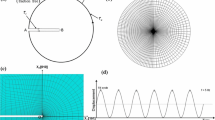Abstract
Laird and Smith [(1962). Philosophical Magazine 8, 847–857] proposed a plastic sliding-off mechanism for the stage II fatigue crack growth via striation formation. In their view, the fatigue crack extension results solely from the changing character of deformation at the crack tip during loading and unloading. In particular, the crack tip blunts during the loading stage and folds into a double notch during the unloading stage, resulting in striation formation. In order to verify Laird’s plastic blunting mechanism for ductile polycrystals as well as for ductile fcc single crystals, FE calculations were performed for a rectangular plate with an initially sharp crack under plane strain conditions. The plate was subjected to a fully reversed tension-to-pressure cyclic load perpendicular to the crack plane (Mode 1). In the single crystal case the crack propagation simulations were carried out for cracks with crack plane (001) for two different crack growth orientations [110] and [100]. No initial radius for the crack tip was assumed. The actual shape of the crack tip followed from an initially sharp crack by repeated remeshing. To model the constitutive behavior typical for polycrystalline ductile metals, J2 hypo-elasto-plasticity model with Armstrong–Frederick kinematic hardening was used. To model the constitutive behavior typical for ductile fcc single crystals, a geometrically nonlinear version of Cailletaud’s model based on the multiplicative elasto-plastic decomposition of the deformation gradient was implemented into the FE program ABAQUS. For simplicity, only octahedral slip systems were considered. Using repeated remeshing for severely distorted elements at the advancing crack tip, deformation patterns in the sense of Laird’s mechanism for fatigue crack propagation with striation formation were obtained in the case of the polycrystal simulation as well as in the case of the single crystal simulation for [110] crack growth direction. The simulation for [100] crack growth direction with the same stress level as for [110] direction also yielded crack extension by progressive large deformations but without striation formation. The dependence of the fatigue striation formation on the crack growth direction as predicted by the simulation of crack propagation in single crystals is verified by the experimental results of Neumann [(1974). Acta Metallurgica 22, 1155–1165] on pure copper single crystals.
Similar content being viewed by others

References
P.O. Bouchard F. Bay Y. Chastel (2003) ArticleTitleNumerical modelling of crack propagation: automatic remeshing and comparison of different criteria Computer Methods in Applied Mechanics and Engineering 192 3887–3908 Occurrence Handle10.1016/S0045-7825(03)00391-8
I. Gu R.O. Ritchie (1999) ArticleTitleOn the crack-tip blunting model for fatigue crack propagation in ductile materials Fatigue and Fracture Mechanics, ASTM STP 1332 552–564
R.W.K. Honeycombe (1968) The Plastic Deformation of Metals Edward Arnol (Publishers) Ltd. London
C. Laird G.C. Smith (1962) ArticleTitleCrack propagation in high stress fatigue Philosophical Magazine 8 847–857
F.A. McClintock (1967) ArticleTitleDiscussion to C. Laird’s paper “The influence of metallurgical microstructure on the mechanisms of fatigue crack propagation” Fatigue Crack Propagation, ASTM STP 415 170–174
L. Meric P. Poubanne G. Cailletaud (1991) ArticleTitleSingle crystal modeling for structural calculations: part 1 – model presentation Journal of Engineering Materials and Technology 113 162–170
P. Neumann (1974) ArticleTitleNew experiments concerning the slip process at propagating fatigue cracks Acta Metallurgica 22 1155–1165
O. Nguyen E.A. Repetto M. Ortiz R.A. Radovitzky (2001) ArticleTitleA cohesive model of fatigue crack growth International Journal of Fracture 110 351–369 Occurrence Handle10.1023/A:1010839522926
R.M.N. Pelloux (1970) ArticleTitleCrack extension by alternating shear Engineering Fracture Mechanics 1 697–704 Occurrence Handle10.1016/0013-7944(70)90008-1
R.O. Ritchie (1999) ArticleTitleMechanisms of fatigue-crack propagation in ductile and brittle solids International Journal of Fracture 100 55–83 Occurrence Handle10.1023/A:1018655917051
Suresh, S. (1998). Fatigue of Materials. Cambridge University Press.
Tvergaard, V. and Hutchinson, W. (2002). Crack growth per cycle by blunting and void growth. In: Fatigue’2002, Proceedings of Eighth International Fatigue Congress (edited by Blom, A.F.), Stockholm, Sweden, Vol. 1, EMAS, U.K., 107–116.
V. Tvergaard (2004) ArticleTitleOn fatigue crack growth in ductile materials by crack-tip blunting Journal of Mechanics and Physics of Solids 52 2149–2166 Occurrence Handle02225684
J. Wu F. Ellyin (1996) ArticleTitleA study of fatigue crack closure by elastic–plastic finite element analysis for constant-amplitude loading International Journal of Fracture 82 43–65 Occurrence Handle10.1007/BF00013240
Author information
Authors and Affiliations
Corresponding author
Rights and permissions
About this article
Cite this article
Levkovitch, V., Sievert, R. & Svendsen, B. Simulation of Fatigue Crack Propagation in Ductile Metals by Blunting and Re-sharpening. Int J Fract 136, 207–220 (2005). https://doi.org/10.1007/s10704-005-6024-y
Received:
Accepted:
Issue Date:
DOI: https://doi.org/10.1007/s10704-005-6024-y



